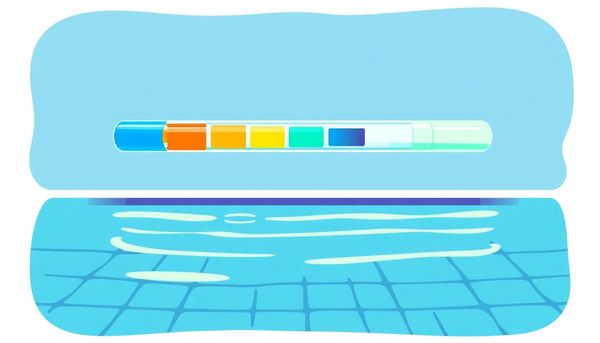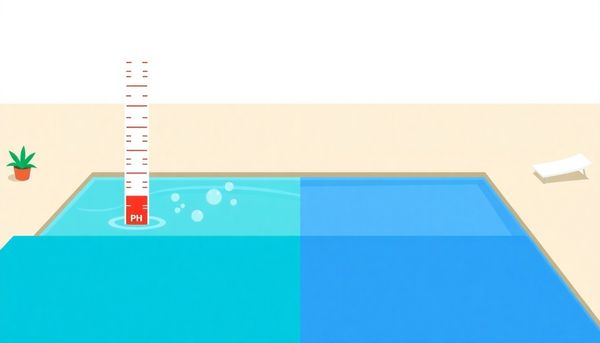Master Pool pH Balance: Essential Tips for Clear Water
December 17th, 2024
December 17th, 2024
When it comes to maintaining a crystal-clear swimming pool, understanding the intricacies of pH levels is crucial. Many pool owners may find themselves bewildered by a sudden rise in their pool's pH, turning what should be a refreshing oasis into a breeding ground for algae and irritation. My own experience with pool maintenance began last summer when I was confronted with a pool that seemed more like a science experiment gone awry. The water had turned a curious shade of cloudy, and swimmers were complaining of itchy skin and burning eyes.
The importance of balancing pH cannot be overstated. A pool with a high pH level—anything over 7.6—becomes unfriendly to swimmers and can wreak havoc on the pool's filtration system over time. Fortunately, rectifying this isn't as daunting as it seems. By using common chemicals readily available at most pool supply stores, you can swiftly restore your pool to its inviting best. From muriatic acid, which offers a potent solution for pH woes, to sodium bisulfate, a gentler alternative, there are multiple paths to achieving the desired balance.
In this guide, we'll delve into the chemical processes at play and explore the most effective substances to lower pH quickly. Drawing from both practical experience and expert advice, you'll gain the confidence to tackle pH imbalances with ease, ensuring your pool remains a safe and delightful retreat.

Tending to your pool’s pH is much like adjusting the ingredients in a recipe. Just as a pinch too much salt can spoil a dish, allowing your pool's pH to veer too high can lead to several unwanted problems. High pH means your chlorine is less effective, potentially inviting algae to the party and leading to cloudy waters—far from inviting. Moreover, swimmers may find themselves with itchy skin and red eyes, not to mention the toll it takes on swimsuits, causing them to fade prematurely.
To bring balance back, sodium bisulfate, known as a pH decreaser, can be a gentle hero. It’s user-friendly and straightforward. Simply measure the current pH and alkaline levels using a reliable testing kit, and then follow the manufacturer’s instructions on how much of the product to add. Remember, it’s best to err on the side of caution—start with a smaller amount, letting it circulate for at least four hours, then test again. This gradual approach prevents overcorrection, which can sometimes lead to further adjustments.
If a more robust solution is needed, muriatic acid is your go-to, although it requires careful handling. Always don protective gear and ensure proper ventilation. Dilute it in water before adding it to the pool, and let your filtration system work its magic. After an hour, check to see if the pH has settled into the desired range of 7.4 to 7.6, ensuring your pool is once again a safe, sparkling oasis.
Consider those sunny afternoons when the pool beckons with its promise of refreshment, only to surprise you with a bit too much sting in the eyes. This discomfort often signals a high pH level, which can disrupt the delightful balance of water chemistry. To ensure your pool remains a haven of relaxation rather than irritation, a couple of chemicals can come to the rescue: sodium bisulfate and muriatic acid.
Sodium bisulfate, known colloquially as a pH decreaser or dry acid, is a favorite among pool owners for its relative safety and ease of use. It’s granular and less corrosive, making it a user-friendly option. Adding this chemical is straightforward: measure the required amount based on your current and target pH levels, sprinkle it into the water near the return jets, and let the pool’s circulation system do the work. I remember a friend who swears by it, claiming it keeps his pool sparkling without the drama of harsh reactions.
On the other hand, there’s muriatic acid, which is powerful and effective but demands respect and caution due to its highly corrosive nature. Proper gear—gloves, goggles, and long sleeves—is non-negotiable when handling this liquid. Diluting it in water before adding it to the pool can help mitigate splash risks. This method, while more intense, is often favored by those who need to address more stubborn pH imbalances quickly.
Regular testing and careful application of these chemicals not only maintain pH levels but also enhance the lifespan of your pool equipment and the comfort of every swim.
Before jumping into quick fixes for pH issues in your pool, it's crucial to first address alkalinity. Think of alkalinity as the peacekeeper of your pool water, maintaining stability and preventing wild swings in pH levels. When alkalinity is not in its happy place, typically between 100 to 150 parts per million (ppm), pH can become a bit of a loose cannon.
Take my friend Alex, who once tried to fix his pool's pH without checking the alkalinity first. He added muriatic acid, thinking it would solve the problem, but ended up with an even more chaotic pool situation. The pH yo-yoed, and his pool water lost its clarity. This only reinforced the importance of getting alkalinity in check.
If your pool's total alkalinity is too low, yet the pH is above 6.8, an alkalinity increaser can help stabilize your levels. Conversely, a high alkalinity can be tempered with a pH decreaser like sodium bisulfate, which conveniently lowers both alkalinity and pH. This dual-action can simplify your chemical balancing act. However, remember to adjust gradually; drastic changes can lead to more trouble than good.
In essence, by managing alkalinity first, you're laying a solid foundation for effective pH adjustment. This approach saves time and resources, making pool maintenance less of a chore and more of a predictable routine. Remember, a balanced pool is a happy pool, and it starts with understanding the relationship between alkalinity and pH.
Balancing a pool's pH is both an art and a science, much like baking the perfect cake. One key to preventing high-pH issues is understanding how various elements affect your pool's chemistry. Everything from the weather to the number of swimmers can tip the scale, making regular testing a must. Testing your pool water at least once a week—and more often during heavy use or after storms—can help you stay ahead of any potential problems.
In addition to frequent testing, maintaining your pool’s alkalinity levels acts as a safety net for pH stability. Alkalinity serves as a buffer, minimizing drastic pH swings. If your alkalinity is stable and within the recommended range of 100 to 150 ppm, your pH levels are less likely to spike unexpectedly. Think of alkalinity as the support beams holding up the structure of your water chemistry—strong beams mean less risk of collapse.
Another proactive step involves controlling what goes into your pool. Encourage swimmers to rinse off before diving in, reducing the oils and contaminants that can disrupt pH balance. For those with saltwater pools, it's crucial to monitor salt levels, as these systems naturally lean towards higher pH. And don't forget the power of pool features such as waterfalls or fountains. These keep water moving, enhancing aeration, which can naturally help manage pH levels without additional chemicals.
In essence, preventing high-pH issues requires a balanced mix of vigilance, routine, and understanding the pool's unique ecosystem. By integrating these practices into your pool maintenance routine, you can enjoy clearer water and a more pleasant swimming experience.

Navigating the world of pool chemicals can be as daunting as remembering algebra after summer break, but using a pH decreaser doesn’t have to be. When you're faced with an unbalanced pool, sodium bisulfate, also known as dry acid, becomes your trusty sidekick. It’s the gentle giant of pool chemicals—safer than muriatic acid and relatively straightforward to handle. However, even superheroes require a bit of finesse to achieve the desired outcome.
Before grabbing your bag of sodium bisulfate, ensure your pool’s pH and alkalinity levels are properly tested. These two metrics dance a delicate tango and often need simultaneous adjustment. Let’s say your pool reveals a pesky high pH and elevated alkalinity; this is where the pH decreaser steps in, lowering both without the drama. Remember, the manufacturer’s instructions are more than mere suggestions—they’re your map to success. Begin conservatively; adding too much at once can be as problematic as not adding enough.
Once you’ve decided how much to use, apply it directly to the water, focusing on the return jets and the deepest sections. Keep the pump running to assist in dissolving the chemical efficiently. A windless day is ideal to prevent the powder from becoming airborne and blowing back at you—a lesson you don’t want to learn the hard way.
After the initial application, let the pump circulate the water and the chemical for a bit. Retesting the pool's pH within 24 hours is a wise move to ensure the levels have settled where they should be. If the pH is still playing hard to get, you may need to repeat the process, adding more decreaser as needed. Remember, when it comes to balancing your pool's chemistry, patience is your best friend.
Every pool owner knows the frustration of maintaining that perfect water balance. Yet, there's one secret weapon often overlooked in this battle: the synergy between pH and alkalinity. Alkalinity acts as your pool's defense line, stabilizing pH fluctuations. Think of it as the unsung hero quietly ensuring your pool water stays hospitable. Without it, your pH levels would swing wildly at every provocation, like a pendulum on a breezy day.
Imagine dealing with a pH that refuses to settle down. You might have added all the right chemicals, but without proper alkalinity, it's like trying to paint on a moving canvas. Ideally, your pool's total alkalinity should nestle between 100 and 150 ppm. If you find it too low, adding an alkalinity increaser can bolster your pH's stability. Conversely, if it's too high, a pH decreaser such as sodium bisulfate can pull double duty, lowering both alkalinity and pH.
Reflecting on my own pool management, I remember a summer when my pH was persistently high despite repeated interventions. A quick check revealed my oversight: neglected alkalinity. Once corrected, the pH settled, the water cleared, and the family's swims became irritation-free adventures. So, before you tackle pH head-on, give your alkalinity the attention it deserves—it's often the key to a harmonious pool environment.
Amidst the myriad of chemicals lining the pool care aisle, choosing the right one to lower your pool's pH can seem daunting. Yet, the decision often boils down to two key players: sodium bisulfate, commonly marketed as a pH decreaser, and muriatic acid. Each has its own quirks and considerations.
Sodium bisulfate is like the mildly eccentric friend who always plays it safe. Known as dry acid, it offers a gentle approach to pH adjustments. When my neighbor first tried it, she marveled at how straightforward it was—just a sprinkle near the return jets and let the pump do its magic. This less corrosive option is ideal for those who might be a bit wary of handling harsher chemicals. However, the trade-off is cost; it tends to lean towards the pricier side of the spectrum.
On the other hand, muriatic acid is the heavyweight champion for those who aren't faint of heart. A few summers ago, I recall a fellow pool enthusiast sharing tales of his cautious dance with this potent liquid. It's a robust solution that swiftly tackles high pH levels, but demands respect and protective gear—gloves, goggles, and a mask are non-negotiable. Its effectiveness is unmatched, yet requires careful handling to avoid damaging your pool's surfaces.
Ultimately, the choice hinges on your comfort level with each chemical and the specific needs of your pool. Whether you prefer the gentle touch of sodium bisulfate or the assertive results of muriatic acid, ensure you're equipped with knowledge and safety gear to keep your pool inviting and safe.
Handling pool chemicals is a bit like cooking with hot oil—proceed with caution, or you'll end up with more than just a mess. Whether it's the gentler sodium bisulfate or the formidable muriatic acid, these substances demand respect. They’re essential allies in your battle to tame the pool's pH, but remember, they can be as unruly as the pH levels you're trying to adjust.
Begin by donning your armor: protective gloves, goggles, and clothing. This isn’t overkill; it's your first line of defense against irritating splashes and harmful fumes. If you’ve ever felt the sting of chlorine in your eyes, you’ll understand the wisdom in this.
Remember, the weather is your partner in this process. Windy days can turn a simple task into a chemical concert, with particles flying everywhere except where they're needed. Choose a calm day to ensure your efforts aren't scattered to the breeze.
Speaking of chemistry, never forget the golden rule: always add chemicals to water, not the other way around. This prevents the dramatic reactions that can occur if you reverse the process. Diluting substances like muriatic acid before adding them to your pool can also minimize risk.
Finally, patience is key. Allow the pool’s filtration system to do its magic, circulating and dissolving these chemicals thoroughly before diving in for a swim. This not only ensures effective pH correction but also safeguards your skin and eyes from any lingering traces.

When it comes to adjusting the pH in your pool swiftly, muriatic acid stands as a formidable ally. Often used by seasoned pool owners, this potent chemical offers an efficient way to bring down those stubborn high pH levels. My neighbor, a longtime pool enthusiast, swears by it after a summer storm leaves her pool's chemistry in chaos. However, the strength of muriatic acid requires respect and caution.
Begin by donning protective gear—long sleeves, gloves, goggles, and a mask are non-negotiable. This is not just about keeping your pool pristine but ensuring your safety as well. Once you're suited up, check your pool's pH and alkalinity levels. A pH above 7.8 is your signal to act. For a standard 15,000-gallon pool, adding around a quart of muriatic acid should start the adjustment process. Remember, smaller pools require less, so moderation is key.
Dilution is the next step. Mix the acid in a bucket with water, maintaining a 10:1 water-to-acid ratio, to prevent splashing hazards. Pour the mixture slowly into the pool, ideally near the return jets, which help in circulating the acid evenly. Let your pool's filtration system do its job, circulating the water for about an hour before retesting.
If the pH remains high, add more acid gradually. Always keep the pool’s filter running during this process to avoid concentrated acid collection that could damage your pool liner. While it’s tempting to rush the process, patience is crucial—resist the urge to swim until your pool’s levels stabilize, usually within a day after treatment. This ensures not just a sparkling pool but a safe haven for summer fun.
Understanding the current pH levels in your pool is like decoding a secret message from the water itself. It’s a vital step before reaching for any chemicals. After all, how do you know what’s needed if you haven’t yet assessed where things stand? For this task, a reliable test kit or pH test strips become your indispensable allies. These tools reveal the precise pH level, guiding your next steps with clarity.
My friend once shared a tale of an unexpected algae bloom, all because his pool’s pH had silently crept up without regular testing. He learned the hard way that neglecting this simple check could lead to cloudy water and irritated swimmers. Ideally, pool pH should hover between 7.4 and 7.6, a sweet spot that ensures swimmer comfort and maintains the effectiveness of chlorine disinfectants.
Additionally, don’t overlook the influence of total alkalinity, which acts as a stabilizing force for pH levels. If alkalinity strays outside the optimal 100-150 ppm range, it can drag the pH along with it. This interconnectedness emphasizes why adjusting total alkalinity first can often make pH adjustments smoother. Armed with this knowledge, the next time you test your pool, you’ll not only glimpse the current state of your water’s balance but also chart a course towards a clear and welcoming swimming environment.
Handling pool chemicals is akin to orchestrating a careful dance, but with the added necessity of safety. Ever tried to juggle a delicate chemical balance while ensuring no splashback onto your skin? It's a challenge that pool owners face, and preparation is your best partner. Safety begins with gear. Think of donning thick gloves, goggles, and long-sleeved attire as your essential armor. It may not be the most fashionable poolside look, but it’s your frontline defense against chemical reactions on your skin.
When working with corrosive agents like muriatic acid, timing and condition are key. Choose a calm day, as wind can turn a simple task into a chemical hazard with one gust. Even the gentler sodium bisulfate demands respect, avoiding windy days to prevent powder drift. Always store chemicals in a cool, dry place, away from direct sunlight, and ensure containers are sealed tightly. This isn’t just about keeping your chemicals potent; it’s a safeguard against unintended exposure.
Another critical step is carefully reading the manufacturer’s instructions. You wouldn’t try assembling furniture without the manual, right? The same applies here. Each product has its quirks and specific dosages, and knowing them can prevent mishaps. Remember, it’s easier to add more chemicals than to remove excess. Start with a conservative amount, and test your water regularly. Safety isn’t about avoiding risk entirely but managing it wisely while keeping your pool a haven of relaxation and fun.
Handling muriatic acid is not to be taken lightly. Before you even think about grabbing that bottle, pause for a moment and consider the necessary precautions. Picture this: a sunny afternoon, the perfect time to enjoy your pool. But first, let’s make sure your pH is in check. Muriatic acid, while effective, requires serious respect. Suit up like you’re about to do battle—long sleeves, pants, gloves, goggles, and a mask are your armor against potential harm. Even a whiff of its fumes can be overwhelming.
A gentle breeze can quickly become your enemy, so choose a calm day for the task. With the wind in your favor, test your pool’s pH and alkalinity. Keep in mind that muriatic acid will lower both, but not always by the same amount. If your pH reads above 7.8 and your pool holds about 15,000 gallons, start with a conservative approach: add about 1 quart of acid. Smaller pools? Begin with a cup. Diluting the acid in a bucket of water—at a 10:1 ratio—can reduce risks and ensure easier handling.
Once you’ve added the acid, let your pool’s filter do the work. Circulate the water for an hour, then retest. If your levels are still above target, don’t rush. Gradually introduce more acid as needed. Patience is key. If swimming is on the agenda, give the chemical a solid 24-hour buffer, particularly if a larger quantity was used. Safety first, always, then dive into your crystal-clear pool with confidence.
Balancing a pool's chemistry can feel like a science experiment, with beakers and test tubes replaced by vials and strips, while the backyard becomes your lab. Yet, amidst all the pH adjustments, there's a quiet hero in the story of pool maintenance: alkalinity. Think of it as your pool's unsung stabilizer, maintaining a steady course in a sea of fluctuating pH levels.
In my own pool adventures, I’ve learned that before you even think about adding those chemicals to refine your pH, it's vital to scrutinize your total alkalinity. Total alkalinity functions as a cushion for the pH levels, essentially absorbing shocks and preventing wild swings. A range between 100-150 ppm is your sweet spot. If your alkalinity is too high, the pH levels will tend to drift upwards, tugging the two into a precarious balancing act.
When I first struggled with high alkalinity, a simple addition of sodium bisulfate did wonders. Not only does it bring the alkalinity down, but it also nudges the pH in the right direction. Conversely, if your alkalinity is on the lower side, consider using an alkalinity increaser to bring stability back to the equation. Remember, each adjustment might require a bit of patience—a lesson I learned after many tests and tweaks. By focusing on alkalinity first, pool maintenance becomes less of a chore and more of a well-rehearsed routine, ensuring that your water remains as clear as a summer day.
The ritual of testing pool chemistry might seem mundane, yet it holds the key to keeping your backyard oasis a sanctuary rather than a breeding ground for discomfort and damage. Consider it akin to checking the oil in your car; without it, everything can veer off course. Your pool's pH level is especially susceptible to change. A neighbor's barbecue smoke, unexpected rain showers, or even the sunscreen slathered on swimmers can tip the pH scale from its ideal of 7.4 to 7.6, edging into murky territory.
To stay on top of this, frequent testing becomes your best ally. At least twice a week, grab a reliable pool test kit. The simple strips or digital testers reveal the secrets of your water's chemistry, hinting when it's time to take action. Personal experience taught me this the hard way—after a particularly stormy week, my pool's pH skyrocketed, leaving guests with itchy eyes and an uninviting cloudy view.
A proactive testing schedule helps catch such fluctuations early, saving both headaches and money. Addressing pH issues sooner rather than later ensures that you won’t need to overuse chlorine, which can disrupt the entire chemical balance and lead to further complications like algae blooms or calcium scale. This vigilance is about more than just clear water—it's about preserving the joy of swimming, free from irritation and the wear and tear on your pool gear.
Adjusting the alkalinity of your pool water might seem like an overlooked step in pool maintenance, yet it holds the key to ensuring a stable and balanced pH level. Think of alkalinity as the backbone that supports the pH, preventing it from swinging wildly from one extreme to the other. This relationship is essential in maintaining clear, comfortable, and safe swimming conditions.
Your total alkalinity should sit comfortably between 100 and 150 parts per million (ppm). When the levels dip below this range, your pool's pH becomes as unpredictable as a summer storm, fluctuating with every splash or gust of wind. On the other hand, if the alkalinity is too high, it can nudge the pH upwards, causing it to spike.
In my early days of pool care, I learned the hard way that skipping this step led to more headaches than solutions. After adding pH decreaser to adjust my pool’s levels, I found myself in a vicious cycle of unstable readings. It was only after focusing on alkalinity first that the numbers began to stabilize, making pH adjustments far more effective and lasting.
Using an alkalinity increaser can help you if levels are too low, while a pH decreaser, such as sodium bisulfate, can lower both alkalinity and pH if they’re too high. By ensuring alkalinity is within its ideal range first, you set the stage for a smoother, more efficient pH adjustment process.
When employing pH decreasers like sodium bisulfate, it’s important to keep safety at the forefront of your pool maintenance routine. This compound, often branded as pH Down or pH Minus, is reliable for correcting high pool pH while being notably less corrosive than its counterpart, muriatic acid. However, even with its reputation for being gentler, mishandling can still lead to unwanted mishaps.
First, check the weather before you start. Wind can turn your careful effort into a cloud of chemicals swirling back at you. One summer, while helping a neighbor adjust their pool's pH, a sudden gust left us both scrambling for cover. Learn from our experience: choose a calm day for your tasks.
Before adding any pH decreaser, test both your pool’s pH and alkalinity levels. Knowing the exact balance helps in determining the precise amount of sodium bisulfate needed. Always follow the manufacturer's instructions—less is more until you become familiar with your pool's quirks. You can always add more, but overdosing requires complex balancing measures.
Introduce the substance into the pool's deep end, near the return jets, and keep your pump running. This ensures thorough mixing and prevents the granules from settling on the bottom, which could harm your pool liner. Remember, undissolved clumps can be brushed away to protect surfaces—just one casual tip that might save you from a costly liner replacement.
Don’t rush to retest immediately; patience here is key. Allow a day for complete chemical circulation, then check if adjustments are still needed. If so, simply repeat the application. With careful handling and a little patience, using pH decreasers can be straightforward and safe.

There's something almost rebellious about a pool with high pH—it's a silent saboteur, quietly undermining the perfect aquatic escape. Neglecting this aspect of pool chemistry isn't merely a cosmetic error; it's an invitation to chaos. Your pool, that shimmering oasis, could transform into a swampy quagmire if left unchecked. Algae parties, clouded waters, and irritated skin are just a sample of the consequences lurking in those high pH waters.
Remember that backyard barbecue last summer? The one where the pool water had everyone itching more than the mosquitoes did? High pH was likely the culprit. When pH rises above 7.8, it compromises chlorine's ability to fight off bacteria effectively, turning your pool party into a potential health hazard. Not to mention, the high pH can cause the luxurious blue of your pool liner to fade, just like that favorite swimsuit of yours.
Let’s also consider your pool equipment. High pH levels lead to calcium scaling, which doesn't just mar the pool's appearance but can clog pipes and damage filters. This isn’t merely about saving face; it’s about safeguarding your investment. Regularly testing and adjusting the pH levels with safe chemicals like sodium bisulfate or muriatic acid can prevent these hazards. Keep that balance, and your pool will stay as welcoming as a cool drink on a sweltering day.
Understanding the delicate dance between alkalinity and pH levels in your pool is like mastering a tricky recipe: get one ingredient wrong, and the whole dish could be off. Alkalinity serves as the stabilizer for pH, much like sugar balances the acid in a good tomato sauce. When your total alkalinity is out of whack, it becomes nearly impossible to adjust pH effectively. This is why starting with alkalinity is crucial—think of it as setting the stage for the main act.
Consider a situation where you're ready to tackle high pH levels, yet your alkalinity isn't within the ideal range of 100 to 150 parts per million (ppm). You might find yourself trapped in a frustrating cycle of pH fluctuations. Once, a friend of mine decided to ignore this step and poured in pH decreaser, only to find his pool's chemistry yo-yoing back and forth. His oversight resulted in wasted chemicals and time.
To avoid similar mishaps, always start by testing both your alkalinity and pH. If your alkalinity is too low, but the pH is above 6.8, reach for an alkalinity increaser to bring stability. If, on the other hand, it's too high, using a pH decreaser like sodium bisulfate might correct both issues simultaneously. Achieving balance first ensures a smoother, more predictable process when adjusting pH. This thoughtful approach not only saves resources but also extends the life of your pool and makes for happier swimmers.

This article provided insights into maintaining your pool. Start your pool care journey today!
Want to become a pool maintenance expert? Our free Pool School course covers everything you need to know about pool care. From basic maintenance to advanced troubleshooting, you'll learn how to:
Join over 10,000 pool owners who have already transformed their pool care routine. Get started with our free Pool School course today!